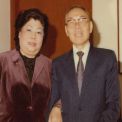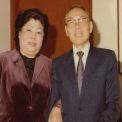-
History & Society
- Education in Pre-war Hong Kong
- History of Taikoo Sugar Refinery
- Hong Kong Products Exhibition
- Local Festivals Around the Year
- Post-war Industries
- Pre-war Industry
- The Hong Kong Jockey Club Archives
- Tin Hau Festival
- Memories We Share: Hong Kong in the 1960s and 1970s
- History in Miniature: The 150th Anniversary of Stamp Issuance in Hong Kong
- A Partnership with the People: KAAA and Post-war Agricultural Hong Kong
- The Oral Legacies (I) - Intangible Cultural Heritage of Hong Kong
- Hong Kong Currency
- Hong Kong, Benevolent City: Tung Wah and the Growth of Chinese Communities
- The Oral Legacies Series II: the Representative List of the Intangible Cultural Heritage of Hong Kong
- Braving the Storm: Hong Kong under Japanese Occupation
- A Century of Fashion: Hong Kong Cheongsam Story
Geography & EnvironmentArt & Culture- Calendar Posters of Kwan Wai-nung
- Festival of Hong Kong
- Ho Sau: Poetic Photography of Daily Life
- Hong Kong Cemetery
- Sketches by Kong Kai-ming
- The Culture of Bamboo Scaffolding
- The Legend of Silk and Wood: A Hong Kong Qin Story
- Journeys of Leung Ping Kwan
- From Soya Bean Milk To Pu'er Tea
- Applauding Hong Kong Pop Legend: Roman Tam
- 他 FASHION 傳奇 EDDIE LAU 她 IMAGE 百變 劉培基
- A Eulogy of Hong Kong Landscape in Painting: The Art of Huang Bore
- Imprint of the Heart: Artistic Journey of Huang Xinbo
- Porcelain and Painting
- A Voice for the Ages, a Master of his Art – A Tribute to Lam Kar Sing
- Memories of Renowned Lyricist: Richard Lam Chun Keung's Manuscripts
- Seal Carving in Lingnan
- Literary Giant - Jin Yong and Louis Cha
Communication & Media- Hong Kong Historical Postcards
- Shaw Brothers’ Movies
- Transcending Space and Time – Early Cinematic Experience of Hong Kong
- Remembrance of the Avant-Garde: Archival Camera Collection
- Down Memory Lane: Movie Theatres of the Olden Days
- 90 Years of Public Service Broadcasting in Hong Kong
- Multifarious Arrays of Weaponry in Hong Kong Cinema
-
History & SocietyGeography & EnvironmentArt & Culture
-
View Oral History RecordsFeatured StoriesAbout Hong Kong Voices
-
Hong Kong Memory
- Collection
- All Items
- Oral History
Recently VisitedOral History

- Innovations made by second-generation: product research and management culture
KL Sun explained how the second generation ran Kin Hip differently from their predecessor from two perspectives: product research and management culture.
(1) Product research: Sun Kin Chao relied on his own insights and judgments when introducing new products, which tended to be more profitable given the larger market and less competition in the early period. Sun Kin Chao often hung around in department stores, outlets and shopping malls to observe the different models of products available in the market. He then modified them in his own products. In 1970, with reference to two models of charcoal grill, Sun Kin Chao took advantage of their good ventilating and soot fending power and introduced a double-tray charcoal grill which sold well and remained popular till now. At the time of the handover to the second generation, the market differed from that of the 1950s and 60s. KL Sun put a great emphasis on market research and data analysis. He would never proceed to tooling and prototyping without adequate customer feedback. Recently Kin Hip introduced a cold drink cup equipped with an ice column, which could prevent lemonades from warming up again or the need for ice cubes. This product was a smash in the market. Since 1984, Sun Kin Chao had faded out of the operation of Kin Hip, yet he kept thinking about new products and occasionally inspected the factory to offer advice.
(2) Management culture: Sun Kin Chao adopted a paternalistic approach in management and made decisions with personal judgments. His subordinates, for the most part, were awed by his authoritativeness. His successor KL Sun decentralized management and involved senior staff members in the decision making process. He was revered rather than feared by his subordinates. When he first returned to Hong Kong for the succession, he spent most of his time in the workshop, urging the workers to work with enthusiasm. Now he had lessened his involvement in daily operation to facilitate the gradual participation by the third generation. KL Sun believed that he played a technical and managerial role, and was more devoted to the policy and strategy of the enterprise comparing with the first generation.

- Creation and promotion of the ‘Kinox’ brand
In 1980, KL Sun created the brand ‘Kinox’, the ‘K’ stood for the company’s English name ‘Kin Hip’ while ‘inox’ was the short form of the French word ‘inoxydable’, the equivalent of ‘stainless steel’. ‘Kinox’ was easier to pronounce than ‘Kin Hip’. A Chinese name ‘建樂士’ was dubbed by Cantonese transliteration. In 1980, the brand was registered in Hong Kong and Beijing and also recognized in the UK. Kin Hip used to print on its products the trademark ‘LH’. Unfortunately ‘LH’ was not a catchy name, which made promotion difficult and its products less than popular in the market. Clients tended to welcome the new brand ‘Kinox’, which saved some lengthy introductions for Kin Hip when it was promoted to clients, and which helped the products enter the chain store market. The ‘Kinox’ trademark was engraved on the tooling of the products. At the request of its clients, Kin Hip sometimes printed the clients’ trademark on the packaging, such as the US distributor Vollrath. Should a trademark be requested to be engraved on the tooling, Kin Hip would decide upon the order size. Now Kin Hip did direct retailing only in the mainland. It relied on agents for marketing in Southeast Asia, Europe and America. KL Sun took Apple iPhone’s supply chain to proclaim the huge profit brought about by retailing. However, he confessed that retailing was not easy to develop. It was vital to launch a new product according to the trend, which would affect Kin Hip’s sustainability.

- Factory expansion: A development from Portland Street, Soy Street, Sung Wong Toi to Kwun Tong
Kin Hip Metalware and Machineries Factory was set up at Portland Street, Mongkok, in 1949. Between 1949 and 1953, Kin Hip operated like an engineering company. It made tooling for pot handles for aluminum pot factories, replaced machine parts for other factories, and offered unique prototypes. Sun Kin Chao lived at Chi Kiang Street in 1949, and later moved his home and factory to Soy Street. In 1953, the year KL Sun was born, Kin Hip also made simple plastic products such as small cups, round combs and hair slides. In 1957, for expansion, Kin Hip’s factory was moved to a vacant lot next to Sung Wong Toi (currently occupied by Mechanical and Mechanical Services Department at Old Kai Tak Airport), where the factory stood alone and saw nothing else of the same trade. The Suns moved their home to Junction Road. Sun Kin Chao built the factory with metal sheets on the vacant lot. Occupying an area of nearly 20,000 sq. ft., the factory came with such equipment as lathes, milling machines, planing machines and ‘monkey machines’ (manual clamping). A workforce of 200 to 300 were employed. The numbers of male and female workers were more or less the same. Male workers did the heavy work of tooling, machinery repair, electroplating, etc, while female workers assembled products such as bicycle horns. The factory hired tooling apprentices who learned about machining and machine repairing. Kin Hip tailored its tooling to its production needs. Metallic decorative lines were plated on plastic products. It also took orders from aluminum pot factories that required electroplating or anodizing of their products such as spittoons.
By the late 1950s, Kin Hip had managed to produce double-layered thermo mugs that combined practicability and artistry on both the inner and outer surfaces. In 1960, Kin Yip moved to Kwun Tong as the government forced the Sung Wong Toi factory to move elsewhere for the expansion of Kai Tak Airport. Sun Kin Chao bought the lot at 30 Shing Yip Street with compensation and built a factory with high ceilings and a pyramid metal roof. Next to it a two-storey concrete building was erected. Its ground floor was deployed as office and sampling room. The upper storey was used as apprentices’ dormitory and warehouse. By 1960, the government had not yet introduced seven-storey public industrial buildings in Kwun Tong. The buildings around Kin Hip were mostly shorter ones. Upon relocation of the factory, the Suns bought a car to commute between home and the factory. The Sun couple spent most of their time in the factory and had their children taken care of by relatives. The family had a gathering every Wednesday and Sunday. In the 1960s, Reclamation Street and Shanghai Street had lots of hardware shops selling metal materials such as stainless steel strips.

- Development of metal and plastic products from 1950s to 1990s
Sun Kin Chao, founder of Kin Hip Metalware and Plastic Factory, came from Shanghai to Hong Kong in 1948. He first worked as a mechanical technician at a factory. In 1949, at Shantung Street, Mongkok, he set up Kin Hip Metalware and Machinery Factory, which repaired machines and made metal tooling of pot handles, pot knob, pot spouts and others for enamel factories and aluminum pot factories. In 1953, Kin Hip started producing utensils and tools such as little red cups for ritual worshipping, screwdrivers, bike horns, plugs of fluorescent tubes by combining metal and plastic materials. Kin Hip had been relocated at Soy Street and Sung Wong Toi in the 1950s. In 1960, it moved to Shing Yip Street, Kwun Tong, producing plastic mugs and water bottles. In 1964, Sun Kin Chao bought land and built a factory at Hung To Road, Kwun Tong, where he started making metal containers.
In 1967, Kin Hip introduced stainless steel kitchenware such as cutlery, trays, butter trays, toast racks, and salt and pepper shakers. In 1979, Kin Hip’s cookwares were available in the market. Kin Hip kept improving its production technology, product variety and outlook design. A built-in thermo conducting layer was added to a newly designed, dumbbell shaped pot with burnished ground glass. In 1996, Kin Hip introduced electric kettles, coffee pots and other electric appliances that incorporated streamline designs and retractable handles. In the 1950s, metal products made in Hong Kong included scissors, screwdrivers, rinsing mugs and others. Manufacturers often referred to overseas designs. Metal products had transformed with the trend. New products were introduced every 3 or 5 years. Sun Kin Chao, with his remarkable sensitivity in market trends, had always been able to introduce insights for new chic products with an emphasis on both quality and technological innovation. This enabled Kin Hip to maintain constant development over the decades and there were few occasions of failure in quality and production.

- Changes of products from 1950s to 1980s, Expansion of plant size and market
Kin Hip began manufacturing in 1953 with plastic worship cups being its earliest product. Back then, worship cups were usually made of metals which were heavy and not widely available as the production volume was low. Responding to market demand, Sun Kin Chao made his own pressing machines and molds, using plastics to mass produce lighter worship cups which proved to be very popular. In those years, Kin Hip bought plastics in small quantities of around 10 lbs from material stores in Sham Shui Po and Central. Sun Kin Chao later improved the quality of the worship cups by engraving each one with three Chinese characters representing “Fortune, Prosperity and Longetivity”. He later recalled that many retired mainland army officers were left unemployed after returning to Hong Kong after World War II. He eventually employed some of these officers to engrave cups at Kin Hip. After launching his first product, Sun Kin Chao began successively developing more complicated product lines. Based on foreign products bought from department stores, he refined the design, made the mold himself and then put the prototype into production. Sun Kin Chao once modified a comb with a round-shape by a unit cost of US$5 by aluminizing it and selling it at the unbeatably low price of just $0.5! In the early 1960s, Sun Kin Chao went on an overseas study trip to Europe with a local manufacturers’ association. While there, he developed great admiration for German-made stainless steel products. Returning to Hong Kong, he developed and experimented with relevant molds. After a series of trials, he launched some square plates as Kin Hip’s first stainless steel product. In these early years, Kin Hip lacked a formal design or engineering department. As a result, Sun Kin Chao perfected each product on his own. In doing so, he endured much hardship and spent long hours at work every day. Over the years, Sun Kin Chao insisted on producing own-brand products and made sure that every product made bore Kin Hip’s logo and refusing to manufacture for other companies.
When Kin Hip’s factory was at No. 56 Soy Street, it began to produce plastic products. Due to inadequate workshop premise, the company moved to Sung Wong Toi in 1957, renting a government plot of 20,000-30,000 square feet. The new plant was sturdily constructed with I-beams and cement walls that were robust enough to withstand wind and rain. At that time, Kin Hip was the only company to set up a facility at Sung Wong Toi. The lack of utilities there meant that Mr. and Mrs. Sun had to arrange water and electricity supplies themselves. In the 1960s, Kin Hip expanded continuously, relocating initially to Shing Yip Street and then to Hung To Road, both in Kwun Tong. Originally seven storeys high, the company’s plant at Hung To Road generated immense profits when it was eventually redeveloped into a 20-storey building. Sun Kin Chao and his wife began their business by opening a factory in Portland Street with a meager capital of just $1,000-2,000. As the company was small, it was difficult to borrow from banks and any profits were generally spent on expanding the factory rather than on personal enjoyment. The Suns operated the business together in the 1950s when Kin Hip had only a few employees. Sun Kin Chao oversaw mold development, design and production, while his wife took charge of the accounts and taking orders. She also looked after the children and prepared the family meals. Not until 1953 did Kin Hip recruit its first apprentice. It was another two years after that before the company hired its first clerk.
When Kin Hip was producing worship cups, its products were mainly sold to hawkers and shops around Soy Street. In those days, worship cups were a very profitable line of business and many hawkers stocked up from Kin Hip. As most hawkers requested credit terms and only paid after the merchandise was sold, Mrs. Sun felt payment collection was not easy. At that time, some hawkers gathered on the Soy Street during the Chinese New Year eve selling cheap daily necessities on the sidewalk. Kin Hip consigned its worship cups to the hawkers so as to gather enough money to pay for worker’s wages and settle bills before the Chinese New Year. When Choi Cheung Kok’s department store later began to buy Kin Hip’s worship cups in bulk, rickshaws had to be hired to deliver the large orders. In the mid-1950s, the company began hiring clerical staff who were proficient in English to write the letters to overseas buyers. Through this, Kin Hip successfully promoted its products to potential buyers overseas. At the same time, staff joined Mrs. Sun in visiting trading firms, distributing samples and taking orders. Kin Hip had also dealt with Indian firms in Hollywood Road and Nam Pak Hong trading firms at Sheung Wan. Between the 1950s and the 1960s, Kin Hip sold its products directly to trading firms who then exported the products to the overseas markets without informing Kin Hip who or where the buyers were. In those years, trading firms tried to delay settling bills for as long as possible. As a result, Mrs. Sun felt visiting creditors asking for payment was a difficult and often fruitless job. In earlier years, Kin Hip relied on trading firms for orders. Whenever Mrs. Sun received calls about potential customers she would immediately hurry to their office so as not to miss out any business opportunities.

- Changes of marketing strategy: indirect sales through agent, business tour and OEM, Introduction ...
Kin Yip Metalware and Plastic Factory commenced productions in 1953. The very first product of the factory was a small red cup for Chinese worshipping ritual. The red cup was made of plastics, and more attractive and durable than the white porcelain cup. It became more popular in the market. This product brought the first success to Kin Hip. The factory subsequently produced circular combs, mugs, screw drivers with lighting function and thermal flasks which were exported to Southeast Asia. Between 1953 and 1964, Kin Yip's products were not directly exported to Southeast Asian countries. Sales could only be made through the franchisees in Southeast Asia commonly known as agents. These agents and their customers were mostly relatives. The former sometimes acted as a banker lending loans to the latter. Hence, most manufacturers found it difficult to adopt this mode of sales as the resale price was made anonymous.
In the early 1960s, stainless steel was a newly developed material and was widely accepted by hospitals. Sun enjoyed the advantage of this market trend and began investigating the use of Stainless Steel in cutlery. Food trays with 2 to 3 compartments, salt and pepper shakers, ice-cream pots and other products were subsequently developed. Stainless steel was relatively harder than copper and aluminum. Both the molding and reshaping processes were more complex. Two sets of tooling might be required in order to produce a stainless steel cup. Kin Hip was the pioneer in Hong Kong’s stainless steel industry, while Chong’s Cutlery and Sunnex Products were the other two sizable manufacturers, the persons-in-charge being Chong Chung Man and Yu Da Cheng respectively. Kin Hip and Chong’s focused on servingware and tabletop cutlery respectively. Sunnex specialized in popular items by mass production, whereas Kin Hip specialized in expensive delicate products. Sun Kin Chao promoted the stainless steel products by sending samples to foreign trading firms, through which the products were exported to famous British cutlery companies such as Viners. Direct export started in 1964.
In 1967, Sun Kin Chao joined a business tour organized by Trade Development Council, and visited Sweden, Denmark, Holland and other countries. He displayed his products in the hotel room he stayed in, directly promoting them to local customers. He also bought new products from these countries, for example, trays from France and cookware from Denmark. Upon his return to Hong Kong, Sun Kin Chao looked into these products and finally developed a wine mixer made of stainless steel. He subsequently introduced more sophisticated products such as western hot pot kit and mixing bowl and spoon. Such products became Kin Hip’s leading products in the 1970s. Kin Hip adopted the mode of original design manufacturing (ODM), in which Kin Hip designed a product and then promoted it to customers. In the early 1970s, Kin Hip was once involved in original equipment manufacturing (OEM). It took from German company Wurttembergische Metallwaren Fabrik (WMF) an order of tens of thousands pieces of gravy boats. The OEM business did not last long in Kin Hip due to the following reasons: 1. Inspection of finished goods was not standardized. The result of the inspection depended on the factory’s relationship with the inspectors. 2. Customers were fussy about the products. Sun Kin Chao preferred autonomy to dependence upon customer’s control. 3. Profit margins of OEM orders was low. In 1996, Kin Hip cooperated with a friend from the electronics field to produce 360° cordless kettles by ODM. This business subsequently shrank due to fierce competition.

- Participating in the Hong Kong Products Exhibitions
From 1957/1958 onward, Kin Hip had set up booths at four Hong Kong Products Exhibitions (the Exhibitions), hiring people with expertise to design the booths for displaying various products such as plastic containers and bicycle horns. In those days, Kin Hip was very focused on export markets. The Sun’s ultimate reason for participating at the exhibitions was to improve their company’s reputation among the local trading firms who used to visit these events to source products for their overseas clients. Two Hong Kong Governors, Sir Robert Black and Sir Alexander Grantham, had visited Kin Hip’s exhibition booths. Over the years, Kin Hip’s double-layered plastic cups won several Exhibition’s Packaging Design Awards. While using the Exhibitions as a channel to meet business partners, Kin Hip continued to concentrate on overseas rather than local sales. As the company eventually succeeded in building stable sales via channels such as sending out product catalogues to overseas customers, it eventually ceased to join the exhibitions. Ultimately, Sun Kin Chao also felt using incentives such as food to attract visitors to their booths did not fit the style of Kin Hip.

- Changes of business mode of Hong Kong-funded enterprises in Mainland China: from compensation tra...
KL Sun pointed out that in the early period of the mainland’s economic reform, Hong Kong manufacturers ran their businesses in the mainland in four major modes: processing in order, producing by sample, assembling by parts and compensation trade. Compensation trade was the earliest business mode. Processing in order came next. The two were not totally the same.
In 1979, at the invitation from Recommendation Office of China Resources Group, KL Sun inspected Nanhai, Panyu and Shunde to look for a site for Kin Hip Metalware and Plastic Factory. He finally chose Nanhai for the factory and ran it by means of compensation trade. Kin Hip provided raw materials, equipment and technical guidance, while mainland units provided factories and workers. KL Sun described that mainland factories were poor equipped for they were still using the ‘monkey machines’, which were no longer used in Hong Kong since the 1950s. That’s why Kin Hip had to provide more advanced equipment for injection moulding, stamping, electroplating, etc. When the products were processed in Nanhai, they were shipped to Hong Kong for packaging and export. In the early years of setting the factory in mainland, mainland logistics were not professional and the truck drivers hauled industrial products by poultry trucks. Kin Hip paid a monthly processing fee to the Nanhai unit and provided the equipment for a price, the ownership of which went to the Nanhai unit. The Nanhai unit assigned a cadre member as Kin Hip’s legal representative. He was a salaried factory director in name, but in reality he only dealt with the Customs, Fire Services and other government bodies. Kin Hip stationed a technical supervisor at the factory. He held the authority to manage all factory affairs. In case of fires or industrial accidents, the legal representative was held responsible criminally. KL Sun was in the opinion that a legal representative could lower the risks of mainland investments made by Hong Kong manufacturers. Kin Hip had not become a legal representative until 1992.
Later on some bad Hong Kong manufacturers forced up equipment prices (commonly known as ‘exploiting an advantage’), preying on mainland units’ earnings from the processing charges. The mainland authority concerned corrected the defect of compensation trade by introducing the three above mentioned modes such as processing by order. Hong Kong manufacturers retained their ownership to the equipment, which were lent to the cooperating units for free. The External Economics and Trading Office (EETO) verified the processing charges. Since then Kin Hip had opted for these three modes of operation. In that year Kin Hip already moved to Shilong, Dongguan. Later on PRC promoted ‘Sino-foreign Equity Joint Venture Law’, and the Shilong unit requested to become a joint venture with Kin Hip. To KL Sun, a joint venture would benefit the town’s unit in many ways, for instance, tax relief and foreign currency income. Because Kin Hip did not want to lose control, the factory moved to Pinghu, Shenzhen, where no joint venture was demanded by the local unit.

- Turning point for Kin Hip’s investment in Mainland China: The 1989 June 4th incident, Closing do...
The 1989 June 4th incident became a turning point for Kin Hip’s setup of factories in the mainland. Given that many Hong Kong manufacturers retreated from the mainland, KL Sun kept investing in the mainland after discussing with his family. To KL Sun, the economic reform was the major drive for the mainland. The people there were determined to improve their lives. Mainland officials welcomed foreign investors to set up factories. The Suns founded their career both in mainland and Hong Kong. It was costly for the family a as well as their career to move elsewhere. Setting up factories in Southeast Asia was posed by problems such as cultural differences and political turmoil. On the other hand, the Pinghu Government made every effort in retaining Hong Kong manufacturers, who allowed sound incomes in foreign currency to be made by towns through processing work. Those incomes need not be paid to the Central Government. In 1989, Kin Hip kept expanding and planned to build a factory in Pinghu. Provided with a privileged land price of $100 HK dollar/sq. m. from the local government as well as a loan from HSBC, Kin Hip kicked off the construction of a new factory in Pinghu. The construction of the new factory was a huge project involving accessibilities to water, electricity and roads and the leveling of land. There were even mountains to remove. The production site, office and dormitory for workers were built during different stages.
In 1992, with the completion of the new factory and the closing down of Hong Kong productions, the majority of Hong Kong staff was dismissed lawfully while many veterans took the chance to go for retirement. Only 10 staff members remained. They were stationed in Pinghu as technical supervisors. Only 2 were left now. The period of 1979 to 1992 was a transitional period of Kin Hip’s shift to the mainland. There used to be production lines and machinery and tooling departments in both Hong Kong and the mainland. The most labour-intensive procedures were shifted to the mainland first, leaving the automated ones in Hong Kong. The departments in Hong Kong dealt with the final assemblies and the issue of origin of the products. Kin Hip was not a labour-intensive factory. The Hong Kong factory had only some 300 workers at its peak. After the shift to the mainland, the number of workers in all the factories rose to 1000 or so. Now most productions in mainland factories were outsourced. KL Sun said due to the mainland’s differences in administrative system, separation of government and party units, and the complicated structure spanning from towns to the Central Government, Hong Kong manufacturers found it hard to get used to them.
Copyright © 2012 Hong Kong Memory. All rights reserved.
| Set Name |





